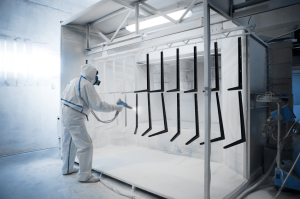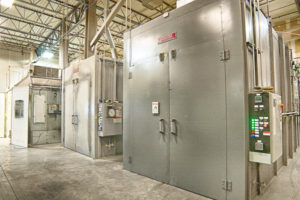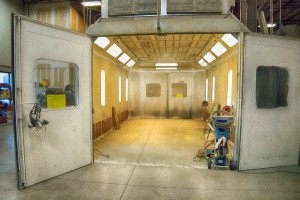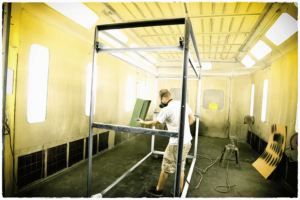 Powder coating is a finish of high quality which may be found on literally thousands of items individuals come into contact with every day. This powder coated paint is used to protect items households depend upon all of the time, as well as extremely tough production machinery. It provides much more durability than liquid paints are able to, yet also leaves a beautiful finish.
Powder coating is a finish of high quality which may be found on literally thousands of items individuals come into contact with every day. This powder coated paint is used to protect items households depend upon all of the time, as well as extremely tough production machinery. It provides much more durability than liquid paints are able to, yet also leaves a beautiful finish.
Types of Powder Coating
The two basic types of powder coatings are thermoplastics and thermosets. Thermoplastic powder coatings melt and flow during the heat process, yet the same chemical composition remains once they have cooled and solidified. The most common type of thermoplastic powder coating used is nylon powder. Thermoset coatings melt when applied to heat as well; however, these cross link with other reactive properties, or within themselves chemically. The chemical composition therefore is altered. NJ Sullivan Company located just outside Washington DC in Sterling, Virginia near Dulles airport does both types of powder coating techniques as well as other finishing work.
The Process of Powder Coating
 Thermoplastic powder coatings are generally used for application to surfaces which have been preheated to temperatures that are much hotter than the melting point of the actual powder. As it is applied to the heated surface, it melts and creates a fusion bond with that surface. It then flows out into a continuous strong film to coat the part. The film develops physical properties as is cools.
Thermoplastic powder coatings are generally used for application to surfaces which have been preheated to temperatures that are much hotter than the melting point of the actual powder. As it is applied to the heated surface, it melts and creates a fusion bond with that surface. It then flows out into a continuous strong film to coat the part. The film develops physical properties as is cools.
Thermoset coatings, as mentioned, also melt, but change chemically. These types are heat stable and will not return to the soft, liquid stage when heated again, unlike thermoplastic coatings. They are created from four standard resin types which include acrylic; epoxy; fluoropolymer; and polyester. The majority of advancements in technology concerning powder coatings have been with the thermosetting type.
 The process used to create powder coatings requires polymer resin systems. They are combined with pigments; curatives; flow modifiers; leveling agents; and other types of additives. These components are melted and mixed, then cooled and ground into a powder that is uniform in nature. This substance is akin to the texture of flour. A process known as ESD, or electrostatic spray deposition, is generally used to apply the powder coating to metal substrates in a thin film finish.
The process used to create powder coatings requires polymer resin systems. They are combined with pigments; curatives; flow modifiers; leveling agents; and other types of additives. These components are melted and mixed, then cooled and ground into a powder that is uniform in nature. This substance is akin to the texture of flour. A process known as ESD, or electrostatic spray deposition, is generally used to apply the powder coating to metal substrates in a thin film finish.
This application uses a type of spray gun which electrostatically charges the tiny particles. This, in turn, causes an attraction to the parts that are grounded. When the application is complete the parts are sent to a heated curing oven. There, the coating reacts chemically and produces long molecular chains, which result as high cross link density. This is the most commonly used method for applying powder coatings.
 Powder coatings are also sometimes applied to non-metallic surfaces, such as MDF, or density fiberboard and plastics. Another instance of powder coating is during fluidized bed application. Parts are preheated and dipped into a hopper filled with fluidizing powder, the powder coating melts, and flows onto the parts.
Powder coatings are also sometimes applied to non-metallic surfaces, such as MDF, or density fiberboard and plastics. Another instance of powder coating is during fluidized bed application. Parts are preheated and dipped into a hopper filled with fluidizing powder, the powder coating melts, and flows onto the parts.
In some cases a post cure may be required depending upon the temperature and mass of the part. The type of powder that is used is another consideration. Powder coating helps prevent quality from diminishing due to moisture; impact; ultra violet light; and chemicals as well as harsh weather conditions. It protects against wear and tear issues such as chipping, scratching, and corrosion. Powder coatings are simple to use, durable, cost efficient, and eco-friendly.